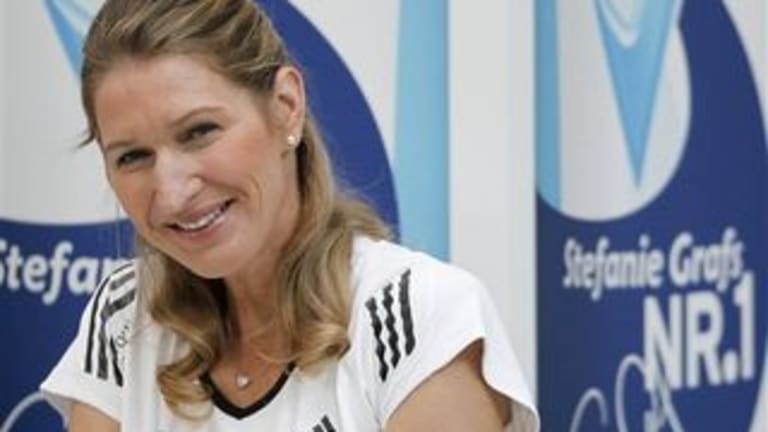Here's a part of her moan, which appeared in an interview in the Spanish newspaper, El Pais: "(Back in the day) We had eight or 10 players who always had an extreme rivalry. And to be number one, or winning a Grand Slam or two, that just didn't come. Now everything is much more open. You can be number one without being a great champion. There is a lot more power in the game, but it lacks variety. If you ask people, they know names of the Williams sisters or Clijsters and Henin, but don't ask them to tell you the name of the number one. (Caroline Wozniacki)."
First off, how tactless can you be? For gosh sakes, Sanchez-Vicario is the tournament director of the Barcelona event -- why didn't she just tell her fellow Barcelonians not to bother buying tickets or coming out to the tournament because the women all stink nowadays? Why doesn't she call a big players meeting and tell all the women how terrible they are?
So let's go back and look at Sanchez-Vicario's record, and see how some of her claims hold up. Granted, the Barcelona Bumblebee won four majors (three at the French Open) and reached the no. 1 ranking (in 1995) in an era dominated by Steffi Graf and Monica Seles. She was a steady force and, periodically, a factor. But bear in mind that she was a big beneficiary of Seles's two-plus-year absence following that horrible stabbing incident in Hamburg. Sanchez-Vicario hit her peak in 1994 and 1995. Seles didn't play at all in '94, and played just a handful of events in 1995 as she hit the comeback trail (and ultimately made the final of the U.S. Open).
The top 10 at the end of 1995 were, in order: Graf and Seles, co-ranked at no. 1 (Seles's no. 1 ranking was protected when she returned to the game), Conchita Martinez, Sanchez-Vicario, Kimiko Date (boo-yeah!), Mary Pierce, Magdalena Maleeva, Gabriela Sabatini, Mary Jo Fernandez, Ivan Majoli and Anke Huber. Take Graf, Seles and Sanchez-Vicario out of the equation and you're looking at a grand total of five Grand Slam titles (Pierce had two, and Martinez, Sabatini and Majoli had one each) for that top 10.
Funny, I don't see Sanchez-Vicario's "eight or ten" players who could be considered "extreme" rivals. The only players in that group who fit the description are Seles and Graf, who were extreme rivals but only with each other. They went at it in the grand, Evert-Navratilova or King-Court manner. Most of the other women were more punching bags than rivals for those two.The career head-to-head between Sanchez-Vicario and Graf is 28-8; nothing too extreme about that, tough as it was to get the measure of the female GOAT. And when it comes to Seles, the odds on a win by Sanchez-Vicario were even worse: the career H2H is 20-3 for Seles.
But give Sanchez-Vicario, if not her theory, credit -- she pushed those two titans, but had a poorer winning percentage against them than some of the other women. Sabatini was a combined 14-40 against Graf and Seles. Martinez was 2-33 against them (ouch!). The most respectable H2H against Graf and Seles was the one posted by a woman who was never ranked higher than no. 3, Pierce. She was an impressive 9-6 against the twin icons.
I suppose Sanchez-Vicario was thinking in career-wide terms, which would introduce the likes of Lindsay Davenport, Jana Novotna, Martina Hingis, and even GOAT runner-up Martina Navratilova. But then you also have to open up the time frame for the women Sanchez-Vicario is implicitly criticizing.
Take Wozniacki, the much dumped-upon Slamless no. 1. She's still at the start of her career, but she's already had to contend with the any-given-day GOAT, Serena Williams, as well as her sister Venus. Then there's Maria Sharapova (otherwise known as Pierce 2.0), Justine Henin (she could play some), Kim Clijsters, Svetlana Kuznetsova, Amelie Mauresmo, Ana Ivanovic, Davenport and Hingis (Wozniacki has played all of them, and all have won majors).
You can see where all this leads. The most salient fact is that Graf and Seles dominated the period in which Sanchez-Vicario played, although her admirable longevity (18 years on the tour) and the inevitable overlap it created may make it seem otherwise to her.
Since Sanchez-Vicario made her remarks, TW regular Sblily has taken exception to the translation posted in our Ticker piece (linked at the top). She says that a more accurate translation of the sentence, You can be number one without being a great champion would be: You can be number one without being champion of a Grand Slam. Fair enough, but I think the potential for a Slamless no. 1 always existed and that's not really the point anyway. The generational claim is the important one.
Sanchez-Vicario also said: "(Back in the day) There was more variety, players with different games, stronger minds, more character. I played with three generations and they evolved. . .If you want to compete in today's game you have to play a much more physical and more power than before.”

